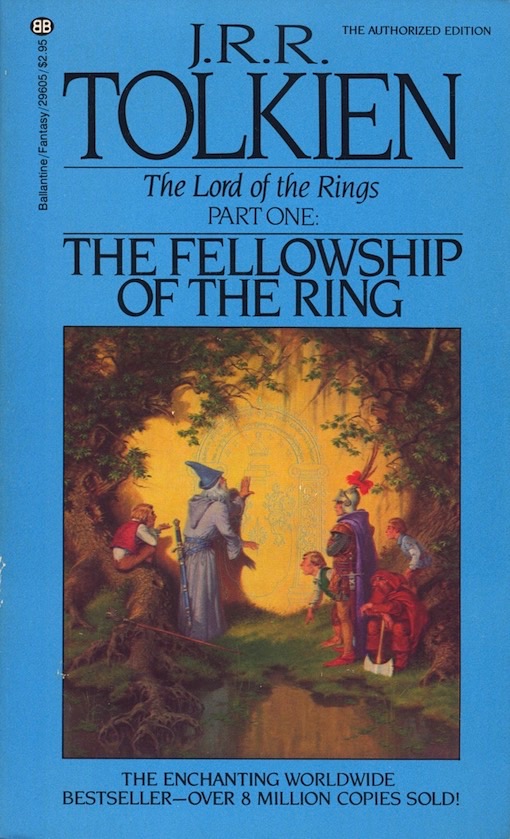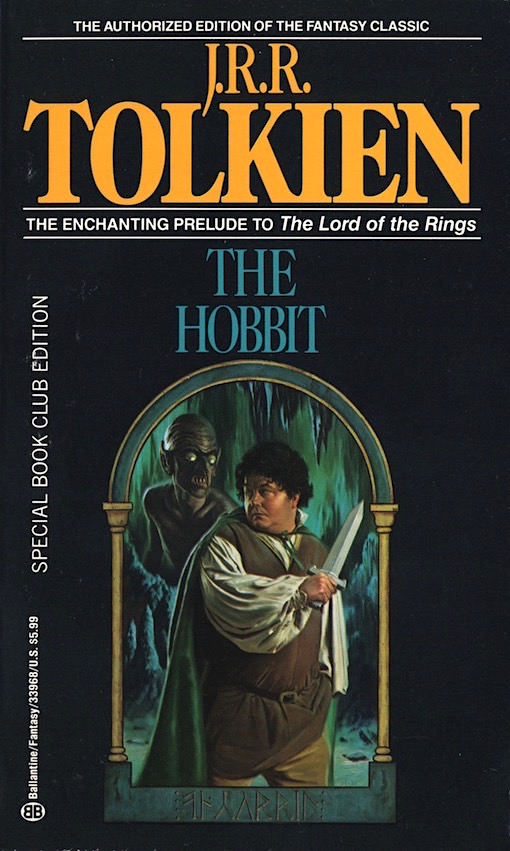I'VE been collecting the various Ballantine/Del Rey mass-market paperback editions of J.R.R. Tolkien's masterpiece, The Hobbit, and its famous sequel, The Lord of the Rings, since I was a teenager in the late 1960's.
For my purposes I only wanted the ones with actual illustrated covers. I don't necessarily need to have key first printings, although like most book collectors I do prefer them. Granted, this hasn't been a difficult mission because there haven't been many cover changes since the books were first published in the United States by Ballantine in 1965. According to the data gathered at TolkienBooks.US, only six for TH, and seven for LOTR (not counting the photo editions or the re-juxtaposition of the same illustration).
The first Ballantine paperback edition of The Hobbit was published in August, 1965 (Catalog ID: U7039), two months in advance of their The Lord of the Rings paperback editions. Artist Barbara Remington was chosen to illustrate the covers. Remington was forced to embellish her illustration after she was given only a vague description of the story by the editor. That's why she drafted a lion, a fruit tree and a pair of emus into her scene, none of which, of course, are found in the book. Tolkien was not happy with her artistic liberties and at his insistence the 'big cat' was erased from all subsequent printings (though inexplicably, none of the other discrepancies were), turning this first printing into an instant collector's commodity. My original copy, which I read to near ruin, was one of the later printings, and I consider myself very lucky to have been able to purchase this now very rare, fine first printing (offset flaws and all), decades after the fact and at a reasonable price.
 |
| CLICK ON IMAGE TO ENLARGE |
Seen above are:
The Two Towers (Ballantine U7041, Oct, 1966, 6th printing, Remington art. Apologies for the scuffed cover).
The Return of the King (Ballantine U7042, Oct, 1966, 7th printing, Remington art).
 |
| 1965 ACE EDITIONS: Cover Art by JACK GAUGHAN. CLICK ON IMAGE TO ENLARGE |
"Not so fast!" said Tolkien, drawing Sting from its scabbard! Then, after a long year of much legal wrangling and continual threats from Sting, the statement was deemed no longer necessary, every pirated edition having been either sold off or removed from stores by Ace and yet it stayed on the back until it was replaced in 1973 by a color photograph of a now obviously happy Tolkien.
The Hobbit (Ballantine 25342, Aug, 1976, 60th printing, Tolkien art. Photo of Tolkien credited to Billett Potter).
Also in 1973, Tolkien's art replaced Remington's art on all three LOTR volumes. His "Hobbiton-across-the water" became the new TFOTR, while "Taur-na-fúin" (Fanghorn Forest) was selected for TTT, and finally, "Barad-dir" for TROTK. All three illustrations were done in pencil, ink and watercolor. The original works were, like Tolkien's drawing for TH, much taller and considerably wider that what was actually allowed on the books.
Seen above are:
The Fellowship of the Ring (Ballantine 25343, Jun, 1976, 57th, Tolkien art).
The Two Towers (Ballantine 25344, Aug, 1976, 54th, Tolkien art).
The Return of the King (Ballantine 25345, Aug, 1976, 53rd, Tolkien art).
 |
| CLICK ON IMAGE TO ENLARGE |
 |
| CLICK ON IMAGE TO ENLARGE |
 |
| CLICK ON IMAGE TO ENLARGE |
 |
| CLICK ON IMAGE TO ENLARGE |
Love him, hate him, or indifferent, there's still no denying the fact that Darrell Sweet was an absolute giant in the field of fantasy. His cover art career, spanning nearly forty years, was both epic in productivity and in quality. His unique, colorful illustrations promoted some of the biggest names in the genre too, such as Piers Anthony, Peter S. Beagle, Terry Brooks, Lord Dunsany, Robert Jordan, Katherine Kurtz, Patricia A. McKillip, L. E. Modesitt, Jr., and Tolkien, to name just a few. Would the Wheel of Time have been as successful without Sweet? Well, yes, almost certainly, but regardless, his contribution to Jordan's overall success cannot be overlooked, or for that matter even properly measured.
Seen above are:
The Hobbit (Ballantine 31858, May, 1984, 8th, Silver Jubilee, Sweet art).
The Fellowship of the Ring (Ballantine 29605, Mar, 1984, 1st, Silver Jubilee, Sweet art).
The Two Towers (Ballantine 29606, Apr, 1984, 77th, Silver Jubilee, Sweet art).
The Return of the King (Ballantine 33209, Apr, 1984, 73rd, Silver Jubilee, Sweet art).
In 1986 Ballantine went back to the same Tolkien art that was used previously. New font and color borders were then added. Although the illustrations were now smaller than their initial presentations, somehow they seemed bolder and more enhanced. Helping matters considerably were probable improvements in both scanning and printing techniques; now each illustration rang truer to their original source material (that being said, smaller made it even harder to make out Mount Doom's volcanic activity on TROTK).
Seen above are:
The Hobbit (Ballantine 33968, Jul, 1986, *17th, Tolkien art).
The Fellowship of the Ring (Ballantine 33970, Jul, 1987, *9th, Tolkien art).
The Two Towers (Ballantine 33971, Jul, 1987, 82nd, Tolkien art).
The Return of the King (Ballantine 33973, Apr, 1987, 79th, Tolkien art).
*(Apparently, during Sweet's time a revised edition of TH was put forth, hence the print number starting back at 1 again, and possibly with LOTR as well, although their numbers didn't change with the exception of the 1987 TFOTR which was now marked as being a 9th. It's all terribly confusing).
Don't judge Michael Herring on the strength of this cover art featured on the 1988 edition of TH and 1987 LOTR's. Instead, take the time to seek out the rest of his artwork, of which there are at least four decades worth of great material, representing fantasy and science fiction but also adventure, romance and mystery. Herring is noted for producing outstanding cover illustrations for popular series such as Baum's Oz, Burrough's The Land That Time Forgot, Don Pendleton's Mack Bolan, Jerry Ahern's T.R.A.C.K., and Stephen Greenleaf's John Marshall Tanner Mysteries--and if that doesn't make your eyes open then take a look at the stone cold brilliance of his James Axler's Deathlands series covers.
Seen above are:
The Hobbit (Ballantine 33968, Jan, 1992, 34th, Special Book Club Edition Box Set, Herring art).
The Fellowship of the Ring (Ballantine 33970, Jan, 1993, 20th, Special Book Club Edition Box Set, Herring art).
The Two Towers (Ballantine 33971, May, 1993, 15th, Special Book Club Edition Box Set, Herring art).
The Return of the King (Ballantine 33973, May, 1993, 19th, Special Book Club Edition Box Set, Herring art).
Ted Naismith produced an entire portfolio of illustrations devoted to Tolkien's works, and if you can somehow view any of them on a larger scale, or in their sequential entirety, then you will appreciate even more the absolute brilliance of what he did depicting Middle-Earth and its inhabitants. His color illustrations are some of the most definitive to date by any artist working under Tolkien's banner. These paperback editions, part of a box set, were issued in the year 2000.
Seen above are:
The Hobbit (Del Rey 33968, 2000, 104th, Naismith art).
The Fellowship of the Ring (Del Rey, 33970, 2000, 98th, Naismith art).
The Two Towers (Del Rey 33971, 2000, 92nd, Naismith art).
The Return of the King (Del Rey 33973, 2000, 95th, Naismith art).
John Howe was another artist who truly "got" Tolkien, and like Naismith, he also has an extensive portfolio of paintings and sketches devoted to Middle-Earth and its inhabitants. Nevertheless, the 2007 editions of LOTR, aren't what I would call his best foot forward, largely due to the cover's terribly restrictive design, but if you could see his artwork in their proper scale and clarity, you would be suitably impressed. This though is the one LOTR set that I don't own--somehow it went under my radar. I hope to fix that in the near future.
Seen above are:
*(Note: Howe's art was not used on any TH mass-market paperback printings).
The Fellowship of the Ring (Del Rey, 2007, 138th, Howe art).
The Two Towers (Del Rey, 2007, 134th, Howe art).
The Return of the King (Del Rey, 2007, 136th, Howe art).
In 2018 Del Rey replaced its LOTR movie-tie-in photo covers, which had been issued off and on since TFOTR's film debut in 2001, with drawings by the "psychedelic" artist Michael James Bowman. These attractive covers were a welcome change from the staidness of the photo editions. In 2020, TH was also reissued with Bowman's art, followed by the entire Tolkien canon. You would be hard pressed to find a more handsomely designed set of twelve paperbacks anywhere on Earth, or Middle-Earth.
Seen above are:
The Hobbit (Del Rey, Jun, 2020, Bowman art).
The Fellowship of the Ring (Del Rey, 2018, 165th, Bowman art).
The Two Towers (Del Rey, 2018, 154th, Bowman art).
The Return of the King (Del Rey, 2018, 154th, Bowman art).
SOMEHOW, inexplicably, I've managed to hang on to the map of Middle-Earth (seen above) that hung on my bedroom wall throughout junior and senior high school. It's now dog-eared and wrinkled, so much so that it now resembles an ancient treasure map. I still cherish it though. It was drawn and embellished in 1969 by Pauline Baynes, but based on the cartography of Tolkien. In 1970 it was issued in poster format and sold in bookstores for a mere $2.50, which I promptly bought. To this day it remains one the greatest gifts that any artist has ever given to fans of Middle-Earth. Barbara Remington also had a map-poster constructed from her cover art, and it too is a treasure for all time.
 |
| Map of Middle-Earth by Pauline Baynes: Click to Enlarge |
 | |||
| Map of Middle-Earth by Barbara Remington: Click to Enlarge |
[© February, 2021, Jeffersen]



































